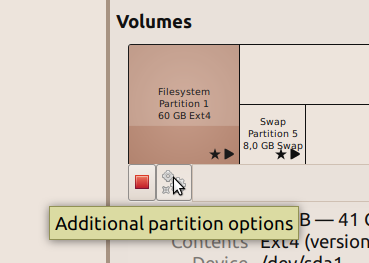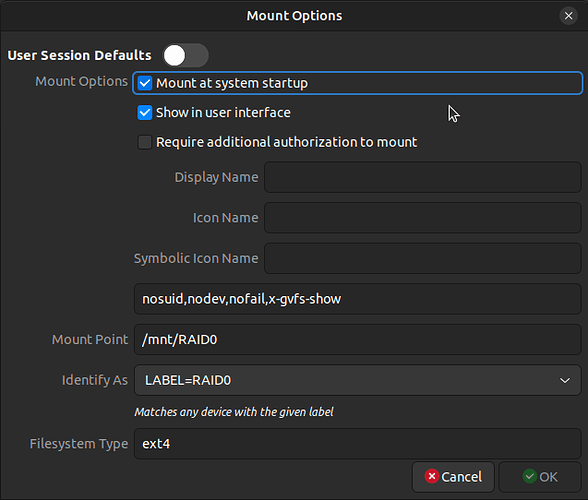Greetings All,
I have been having an issue with A RAID0 staying mounted. Every time I restart my computer, the RAID0 is no longer mounted. I have found a work around, but it requires me to keep reformatting drive (non destructive), reallocate the partition (non destructive0, and mount the partition with the Disks software. Though not well versed in the process, I tried, unsuccessfully, to make changes in FSTAB file. Occasional, I get an the following error during the reallocate-the-partition process:
Error wiping newly created partition /dev/dm-0p1:Failed to open the device ‘/dev/dm-0p1’ (udisks-error-quark,0)
To start this troubleshooting process, I have supplied my system information below. Thank you in advance for your help with this on going issue.
mike@derSchlaefer:~$ sudo inxi -Famxz
[sudo] password for mike:
System:
Kernel: 5.15.0-76-generic x86_64 bits: 64 compiler: gcc v: 11.3.0
parameters: BOOT_IMAGE=/boot/vmlinuz-5.15.0-76-generic
root=UUID=b386fa7b-dbf3-4aec-a3a2-1c39aedc8d93 ro intel_iommu=off
amd_iommu=off quiet splash vt.handoff=7
Desktop: MATE 1.26.0 info: mate-panel wm: marco 1.26.0 dm: LightDM 1.30.0
Distro: Ubuntu 22.04.3 LTS (Jammy Jellyfish)
Machine:
Type: Desktop System: ASUS product: N/A v: N/A serial: N/A
Mobo: ASUSTeK model: ROG STRIX Z590-E GAMING WIFI v: Rev 1.xx
serial: UEFI: American Megatrends v: 0605 date: 03/11/2021
Memory:
RAM: total: 31.18 GiB used: 2.77 GiB (8.9%)
Array-1: capacity: 64 GiB slots: 4 EC: None max-module-size: 16 GiB
note: est.
Device-1: Controller0-ChannelA-DIMM0 size: No Module Installed
Device-2: Controller0-ChannelA-DIMM1 size: 16 GiB speed: spec: 2667 MT/s
actual: 2666 MT/s type: DDR4 detail: synchronous bus-width: 64 bits
total: 64 bits manufacturer: Crucial Technology
part-no: BL16G32C16U4B.16FE serial:
Device-3: Controller0-ChannelB-DIMM0 size: No Module Installed
Device-4: Controller0-ChannelB-DIMM1 size: 16 GiB speed: spec: 2667 MT/s
actual: 2666 MT/s type: DDR4 detail: synchronous bus-width: 64 bits
total: 64 bits manufacturer: Crucial Technology
part-no: BL16G32C16U4B.16FE serial:
CPU:
Info: model: 11th Gen Intel Core i9-11900K socket: LGA1200 bits: 64
type: MT MCP arch: Rocket Lake family: 6 model-id: 0xA7 (167) stepping: 1
microcode: 0x57
Topology: cpus: 1x cores: 8 tpc: 2 threads: 16 smt: enabled cache:
L1: 640 KiB desc: d-8x48 KiB; i-8x32 KiB L2: 4 MiB desc: 8x512 KiB
L3: 16 MiB desc: 1x16 MiB
Speed (MHz): avg: 800 high: 801 min/max: 800/5100:5300
base/boost: 3465/12000 scaling: driver: intel_pstate governor: powersave
volts: 0.9 V ext-clock: 100 MHz cores: 1: 801 2: 801 3: 801 4: 800 5: 801
6: 801 7: 801 8: 800 9: 800 10: 801 11: 801 12: 801 13: 801 14: 801
15: 800 16: 800 bogomips: 112128
Flags: avx avx2 ht lm nx pae sse sse2 sse3 sse4_1 sse4_2 ssse3 vmx
Vulnerabilities:
Type: itlb_multihit status: Not affected
Type: l1tf status: Not affected
Type: mds status: Not affected
Type: meltdown status: Not affected
Type: mmio_stale_data mitigation: Clear CPU buffers; SMT vulnerable
Type: retbleed mitigation: Enhanced IBRS
Type: spec_store_bypass
mitigation: Speculative Store Bypass disabled via prctl and seccomp
Type: spectre_v1
mitigation: usercopy/swapgs barriers and __user pointer sanitization
Type: spectre_v2 mitigation: Enhanced IBRS, IBPB: conditional, RSB
filling, PBRSB-eIBRS: SW sequence
Type: srbds status: Not affected
Type: tsx_async_abort status: Not affected
Graphics:
Device-1: AMD Ellesmere [Radeon RX 470/480/570/570X/580/580X/590]
vendor: XFX Pine driver: amdgpu v: kernel pcie: gen: 3 speed: 8 GT/s
lanes: 8 link-max: lanes: 16 ports: active: DP-1,HDMI-A-1
empty: DP-2,DP-3,DVI-D-1 bus-ID: 01:00.0 chip-ID: 1002:67df
class-ID: 0300
Device-2: EMEET HD Webcam C960 type: USB driver: snd-usb-audio,uvcvideo
bus-ID: 1-10.1:6 chip-ID: 328f:003f class-ID: 0102 serial:
Display: server: X.Org v: 1.21.1.4 compositor: marco v: 1.26.0 driver: X:
loaded: amdgpu,ati unloaded: fbdev,modesetting,vesa gpu: amdgpu
display-ID: :0 screens: 1
Screen-1: 0 s-res: 3840x1080 s-dpi: 96 s-size: 1016x285mm (40.0x11.2")
s-diag: 1055mm (41.5")
Monitor-1: DisplayPort-0 mapped: DP-1 pos: primary,left
model: Sceptre F24 serial: built: 2021 res: 1920x1080 hz: 60
dpi: 94 gamma: 1.2 size: 520x320mm (20.5x12.6") diag: 611mm (24.1")
ratio: 16:10 modes: max: 1920x1080 min: 640x480
Monitor-2: HDMI-A-0 mapped: HDMI-A-1 pos: right model: Sceptre F24
serial: built: 2021 res: 1920x1080 hz: 60 dpi: 94 gamma: 1.2
size: 520x320mm (20.5x12.6") diag: 611mm (24.1") ratio: 16:10 modes:
max: 1920x1080 min: 640x480
OpenGL: renderer: AMD Radeon RX 590 Series (polaris10 LLVM 15.0.7 DRM
3.42 5.15.0-76-generic)
v: 4.6 Mesa 22.2.5-0ubuntu0.1~22.04.3 direct render: Yes
Audio:
Device-1: Intel Tiger Lake-H HD Audio vendor: ASUSTeK driver: snd_hda_intel
v: kernel alternate: snd_sof_pci_intel_tgl bus-ID: 00:1f.3
chip-ID: 8086:43c8 class-ID: 0403
Device-2: AMD Ellesmere HDMI Audio [Radeon RX 470/480 / 570/580/590]
vendor: XFX Pine driver: snd_hda_intel v: kernel pcie: gen: 3 speed: 8 GT/s
lanes: 8 link-max: lanes: 16 bus-ID: 01:00.1 chip-ID: 1002:aaf0
class-ID: 0403
Device-3: EMEET HD Webcam C960 type: USB driver: snd-usb-audio,uvcvideo
bus-ID: 1-10.1:6 chip-ID: 328f:003f class-ID: 0102 serial:
Device-4: ASUSTek USB Audio type: USB
driver: hid-generic,snd-usb-audio,usbhid bus-ID: 1-14:7 chip-ID: 0b05:1996
class-ID: 0300
Sound Server-1: ALSA v: k5.15.0-76-generic running: yes
Sound Server-2: PulseAudio v: 15.99.1 running: yes
Sound Server-3: PipeWire v: 0.3.48 running: yes
Network:
Device-1: Intel Ethernet I225-V vendor: ASUSTeK driver: igc v: kernel pcie:
gen: 2 speed: 5 GT/s lanes: 1 port: N/A bus-ID: 0f:00.0 chip-ID: 8086:15f3
class-ID: 0200
IF: enp15s0 state: down mac:
Device-2: Intel Ethernet I225-V vendor: ASUSTeK driver: igc v: kernel
pcie: gen: 2 speed: 5 GT/s lanes: 1 port: N/A bus-ID: 10:00.0
chip-ID: 8086:15f3 class-ID: 0200
IF: enp16s0 state: down mac:
Device-3: Intel Wi-Fi 6 AX210/AX211/AX411 160MHz driver: iwlwifi
v: kernel pcie: gen: 2 speed: 5 GT/s lanes: 1 bus-ID: 11:00.0
chip-ID: 8086:2725 class-ID: 0280
IF: wlp17s0 state: up mac:
Bluetooth:
Device-1: Intel AX210 Bluetooth type: USB driver: btusb v: 0.8
bus-ID: 1-2:2 chip-ID: 8087:0032 class-ID: e001
Report: hciconfig ID: hci0 rfk-id: 0 state: up address:
Info: acl-mtu: 1021:4 sco-mtu: 96:6 link-policy: rswitch sniff
link-mode: peripheral accept
service-classes: rendering, capturing, object transfer, audio, telephony
RAID:
Hardware-1: Intel Device driver: ahci v: 3.0 port: 7020 bus-ID: 00:17.0
chip-ID: 8086:43d6 rev: N/A class-ID: 0104
Hardware-2: HighPoint Device driver: hptnvme v: 1.5.1 port: 5000
bus-ID: 0a:00.0 chip-ID: 1103:7103 rev: N/A class-ID: 0104
Drives:
Local Storage: total: 1.82 TiB used: 444.28 GiB (23.8%)
SMART Message: Required tool smartctl not installed. Check --recommends
ID-1: /dev/sda maj-min: 8:0 vendor: Crucial model: CT1000MX500SSD1
size: 931.51 GiB block-size: physical: 4096 B logical: 512 B
speed: 6.0 Gb/s type: SSD serial: rev: 033
ID-2: /dev/sdb maj-min: 8:16 vendor: Crucial model: CT1000MX500SSD1
size: 931.51 GiB block-size: physical: 4096 B logical: 512 B
speed: 6.0 Gb/s type: SSD serial: rev: 033
Partition:
ID-1: / raw-size: 930.94 GiB size: 915.25 GiB (98.31%)
used: 304.4 GiB (33.3%) fs: ext4 block-size: 4096 B dev: /dev/hptblock0n0p2
maj-min: 259:2
ID-2: /boot/efi raw-size: 512 MiB size: 511 MiB (99.80%)
used: 6.1 MiB (1.2%) fs: vfat block-size: 512 B dev: /dev/hptblock0n0p1
maj-min: 259:1
Swap:
Kernel: swappiness: 60 (default) cache-pressure: 100 (default)
ID-1: swap-1 type: file size: 2 GiB used: 0 KiB (0.0%) priority: -2
file: /swapfile
Sensors:
System Temperatures: cpu: 27.8 C mobo: N/A gpu: amdgpu temp: 47.0 C
Fan Speeds (RPM): N/A gpu: amdgpu fan: 2
Info:
Processes: 422 Uptime: 11m wakeups: 0 Init: systemd v: 249 runlevel: 5
tool: systemctl Compilers: gcc: 11.4.0 alt: 11/12 Packages: 3066 apt: 3036
lib: 1579 flatpak: 0 snap: 30 Shell: Sudo (sudo) v: 1.9.9 default: Bash
v: 5.1.16 running-in: mate-terminal inxi: 3.3.13

 Having said that and from what I gathered from your posts, it seems to me that:
Having said that and from what I gathered from your posts, it seems to me that:

